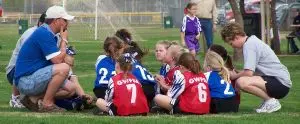
Aug 25, 2011 • 5 min read
Coaching, Spoken and Unspoken
Posted in:
Don’t speak unless you can improve on the silence. ~ Spanish Proverb
I coach a lot of practices and games but occasionally I get to sit back and watch — and listen — to other teams’ practices and games. When I do, I invariably leave with something I like, or don’t like, and those takeaways continue to shape me as a coach.

I watch. I listen. And at most events, there seems to be plenty more to hear than to see. That is, as coaches, we’re apt to talk a lot. In our well intentioned efforts to pass down our insights, we tend to verbally brain dump a deluge of information upon our players. For young athletes, it’s like trying to drink from a fire hose.
But it’s not just what young athletes hear from coaches that can be overwhelming, it’s what they see. They read our body language and never fail to notice their coach’s nonâ€verbal signs of disapproval and frustration. Yet it is how we choose to emotionally react to our players’ performances that is really the only component of the game we can entirely control. If we’re not getting that part right, we’re not otherwise of much use to them.
By observing others coach, I’ve become more reflective on the verbal and nonâ€verbal aspects of my own coaching, and have uncovered a few blind spots that I’d like to work on. Can I be a more effective communicator with fewer, and more thoughtfully selected words for my players? Can I employ more nonâ€verbal and demonstrative communication techniques to teach? And most importantly, am I expressing unintended messages with the spoken and gestural languages I speak?
Here are four verbal and nonâ€verbal coaching ideas to consider:
Say Less, Play More
While plenty has been written on the different modes of learning, I don’t accept that one is universally superior to all others, or that most kids generally learn better one way. However, in youth sports I believe experiential learning — supplemented by only moderate doses of verbal instruction — is most effective. Indeed, I have found that verbal narrative adds very little; most athletic skill development can occur through demonstration, observation, copying, and repetition. Years ago, I coached in Japan and found the language barrier easy to overcome. I learned to coach without a lot of chatter.
Use Key Words
Last spring, my young hitters experienced an offensive breakthrough when a timing concept finally seemed to click for them, all at once. There are entire books written on the subject of the baseball swing, and while the theories are sound in print, there is no room in the batter’s box, or batter’s head, for all that language. So to help my hitters transfer their knowledge to an integrated, rhythmic movement I limited my verbal interference to two simple words during batting practice: “load, explode”. From there, their bodies took over. Nothing more from me was necessary.
And from the base coach box or dugout, I tried to limit my banter. I refrained from full sentences or meaningless and distracting clichés. If I thought one simple reminder could help, I’d offer up one of our key words — but only one I knew they’d recall from practice. I’d say, for example, “Hands” and the adjustment I was hoping for would be made. If it required a more elaborate instruction, I figured, I should save it for practice.
Love Them Most When They Least Deserve It
When a young player makes a mistake, he knows it. And he knows I know it. I don’t need to show him I know it. Instead of kicking the dirt, instead of crowning my head with my hands, instead of wincing with frustration I need to show my player that at least one person who matters — his coach — still has his back, unconditionally. By expressing frustration, even nonâ€verbally, it would also be signaling to my other players that it’s OK to express frustration at teammates. Modeling emotional control, meanwhile, teaches a more intended lesson to the entire team.
My coâ€coach wipes his brow at a player after a gaffe to say, “Hey, no sweat”. I sometimes wink and grin at a player to show him it’s best to just laugh and move on.
Criticize — and Praise — Less
If we’re not careful, it’s easy as coaches to turn into nonâ€stop commentators, constantly dispensing value judgments, both good and bad, about absolutely everything we see everyone doing. It’s exhausting, for everyone. When that happens, players learn to view their coaches as the sole arbiters of right and wrong, and that’s not the intended goal of youth sports.
It’s understandably tempting as both an encouraging mentor and a constructive educator to want to either compliment or correct everything we see. But the impact of our feedback is undoubtedly greater if we pick our spots and mix up the degree, frequency, and delivery method of our views. To paraphrase another familiar saying, a smart coach knows what to say; a wise coach knows whether or not to say it.
What coaching insights do you have regarding verbal and nonâ€verbal communication with players?
 Bruce Reed is a youth sports coach, writer, educator, and father of two. He has coached high school and Little League baseball, youth soccer, basketball, and football and is currently the regional director of Compass Prep.
Bruce Reed is a youth sports coach, writer, educator, and father of two. He has coached high school and Little League baseball, youth soccer, basketball, and football and is currently the regional director of Compass Prep.
